Stakeholders can derail a project faster than bad code or blown budgets. One says, “It needs to be scalable.” Another says, “Just ship it fast,” and suddenly, no one agrees on what success even looks like.
How to align stakeholders on project requirements is not just about gathering input; it's about turning competing agendas into a unified roadmap.
In this article, we will explore:
- Follow these steps to align stakeholders from day one
- Use the right tools to simplify stakeholder alignment
9 proven steps to get every stakeholder on the same page for project success
Getting stakeholders aligned on project requirements isn't just a nice-to-have; it's the difference between project success and costly failure. When stakeholders pull in different directions, projects suffer from scope creep, budget overruns, and missed deadlines.
Follow these nine actionable steps to create unwavering stakeholder alignment that drives your project to success.
1. Identify all stakeholders early (leave no one behind)
Start your stakeholder identification process before your project officially begins. The biggest mistake project managers make is discovering key stakeholders halfway through the project, often due to a missing or vague project charter, leading to major requirement changes and timeline disruptions. Cast a wide net to capture everyone who has a stake in your project's outcome.
Key stakeholder categories to identify:
- Internal stakeholders: Project team members, department heads, executives, support teams
- External stakeholders: Clients, customers, vendors, suppliers, regulatory bodies
- Decision-makers: Those with final approval authority and budget control
- Influencers: People who can sway opinions and drive adoption
- End users: The people who will actually use the final deliverable
- Hidden stakeholders: IT security, legal teams, compliance officers
Pro Tip: Create a stakeholder discovery workshop with your core team. Ask "Who else might be impacted by this project?" until you can't think of anyone new. It's better to have too many stakeholders than to miss a critical one.
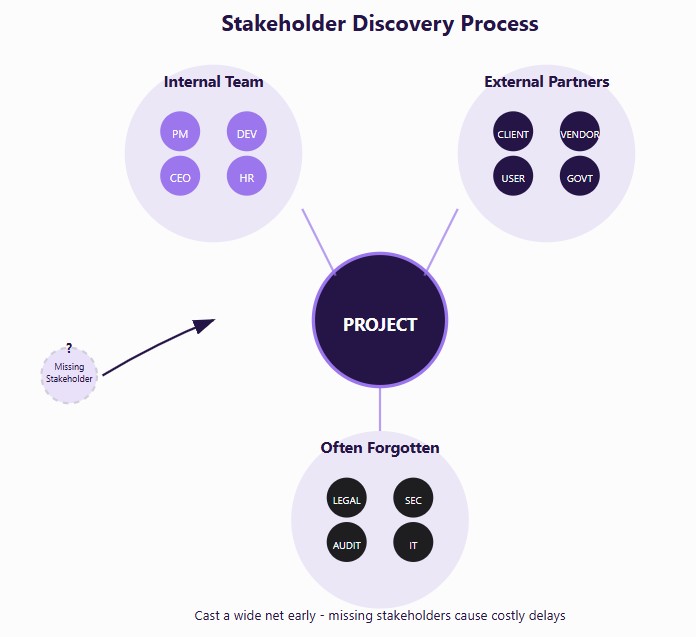
2. Conduct thorough stakeholder analysis (know your players)
Understanding your stakeholders' roles, expectations, and influence levels is crucial, and using a stakeholder engagement plan template can streamline that process for tailored engagement.
Not all stakeholders are created equal; some have high influence but low interest, while others are highly interested but have limited power to affect decisions.
Essential analysis components:
- Power and influence mapping: Who can make or break your project?
- Interest and engagement levels: How invested is each stakeholder in the outcome?
- Communication preferences: Email, meetings, reports, or informal updates?
- Success criteria: What does each stakeholder consider a "win"?
- Potential concerns and objections: What keeps them up at night?
- Relationship dynamics: Who influences whom in your stakeholder network?
Pro Tip: Use the Power-Interest Grid to categorize stakeholders into four groups: Manage Closely (high power, high interest), Keep Satisfied (high power, low interest), Keep Informed (low power, high interest), and Monitor (low power, low interest).
3. Use collaborative requirement-gathering methods (make it interactive)
Requirements gathering isn't a one-way conversation; it's a collaborative discovery process. Traditional methods like sending out requirement documents often fall short because they don't capture the nuanced needs and hidden assumptions that stakeholders hold.
Effective collaborative methods:
- Requirements workshops: Bring stakeholders together for structured brainstorming sessions
- One-on-one interviews: Deep-dive conversations with key stakeholders
- Focus groups: Gather input from similar stakeholder types simultaneously
- Surveys and questionnaires: Collect standardized input from large stakeholder groups
- Observation sessions: Watch end users in their natural work environment
- Prototyping sessions: Let stakeholders interact with early versions
Pro Tip: Use the "Five Whys" technique during interviews. When a stakeholder states a requirement, ask "why" five times to uncover the real underlying need. This often reveals more fundamental requirements that deliver greater value.
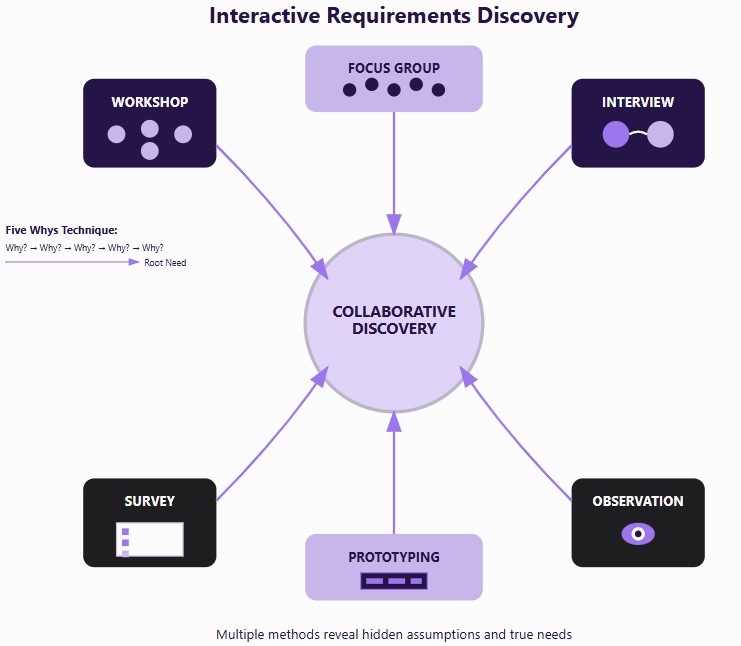
4. Define and document clear, smart requirements (eliminate ambiguity)
Vague requirements are the enemy of stakeholder alignment. When requirements are open to interpretation, different stakeholders will naturally assume different things, leading to misaligned expectations and project conflicts.
SMART requirements criteria:
- Specific: Clearly defined with no room for misinterpretation
- Measurable: Include quantifiable success criteria and acceptance criteria
- Achievable: Realistic given your project constraints and timeline
- Relevant: Directly tied to business objectives and stakeholder needs
- Time-bound: Include clear deadlines and milestones
- Testable: Define how you'll verify the requirement is met
Pro Tip: Write requirements in the format: "The system shall [action] so that [stakeholder] can [benefit]." This format ensures every requirement is tied to a specific stakeholder value and outcome.
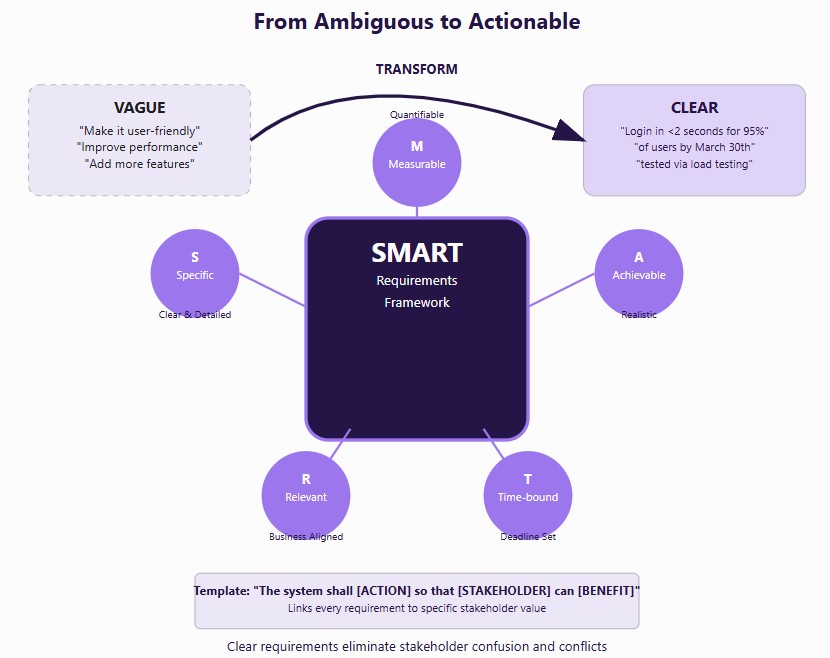
5. Establish a shared language (break down communication barriers)
Technical jargon and industry-specific terminology can alienate stakeholders and create misunderstandings. When stakeholders don't understand what you're talking about, they can't provide meaningful input or give informed approval on requirements.
Shared language strategies:
- Create a project glossary: Define all technical terms and acronyms clearly
- Use plain language: Explain complex concepts in simple, everyday terms
- Provide context: Help stakeholders understand why certain requirements matter
- Standardize terminology: Ensure everyone uses the same words for the same concepts
- Offer training sessions: Educate stakeholders on relevant technical concepts
- Use analogies: Compare technical concepts to familiar everyday experiences
Pro Tip: Start every meeting or document with a brief "terminology check." Ask if anyone needs clarification on terms before diving into detailed discussions. This simple step prevents hours of confusion later.

6. Use visual tools to make requirements tangible (show, don't just tell)
Visual representations make abstract requirements concrete and understandable. When stakeholders can see and interact with visual representations of requirements, they're more likely to spot gaps, conflicts, and improvement opportunities early in the process.
Powerful visual tools:
- Wireframes and mockups: Show how interfaces will look and function
- Process flow diagrams: Illustrate how workflows will operate
- User journey maps: Demonstrate the end-to-end user experience
- System architecture diagrams: Visualize technical relationships and dependencies
- Storyboards: Tell the story of how users will interact with the solution
- Interactive prototypes: Let stakeholders experience the solution firsthand
Pro Tip: Use the "picture is worth a thousand words" principle. For every complex requirement, create a visual representation. Stakeholders who struggle with written requirements often immediately understand visual ones.
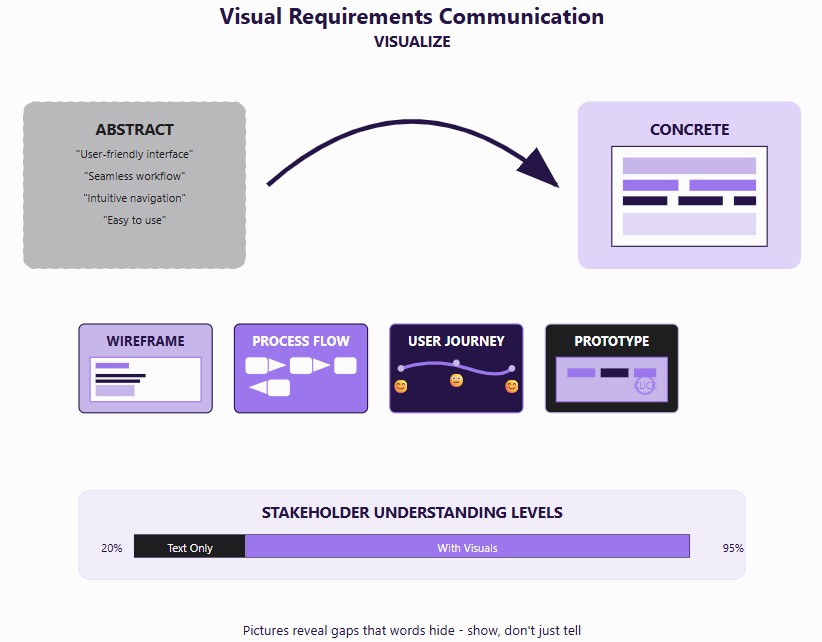
7. Validate requirements with all stakeholders (confirm understanding)
Assumption is the mother of all project failures. Even after thorough requirements gathering, stakeholders may have different interpretations of what was agreed upon. Formal validation ensures everyone truly understands and agrees with the documented requirements.
Validation methods:
- Formal review sessions: Present requirements and gather explicit feedback
- Sign-off processes: Obtain written approval from key stakeholders
- Walkthrough demonstrations: Show how requirements will work in practice
- Pilot testing: Test requirements with a small user group first
- Cross-stakeholder reviews: Have different stakeholder groups review each other's requirements
- Requirements traceability: Link each requirement back to its stakeholder source
Pro Tip: Don't just ask "Do you approve these requirements?" Instead, ask stakeholders to explain the requirements back to you in their own words. This reveals misunderstandings that a simple yes/no question would miss.
8. Create a central source of truth (eliminate confusion)
Scattered requirement documents lead to version control nightmares and conflicting information. When stakeholders work from different versions of requirements, alignment quickly breaks down, and costly miscommunications occur.
Central documentation elements:
- Single requirement repository: One location for all official requirements
- Version control system: Track changes and maintain requirement history
- Access permissions: Control who can view and edit requirements
- Change request process: Formal workflow for requirement modifications
- Regular backups: Protect against data loss and corruption
- Search functionality: Help stakeholders quickly find specific requirements
Pro Tip: Choose a collaborative platform that allows real-time updates and comments. Tools like Confluence, Notion, or specialized requirements management software can transform chaotic document management into seamless collaboration.
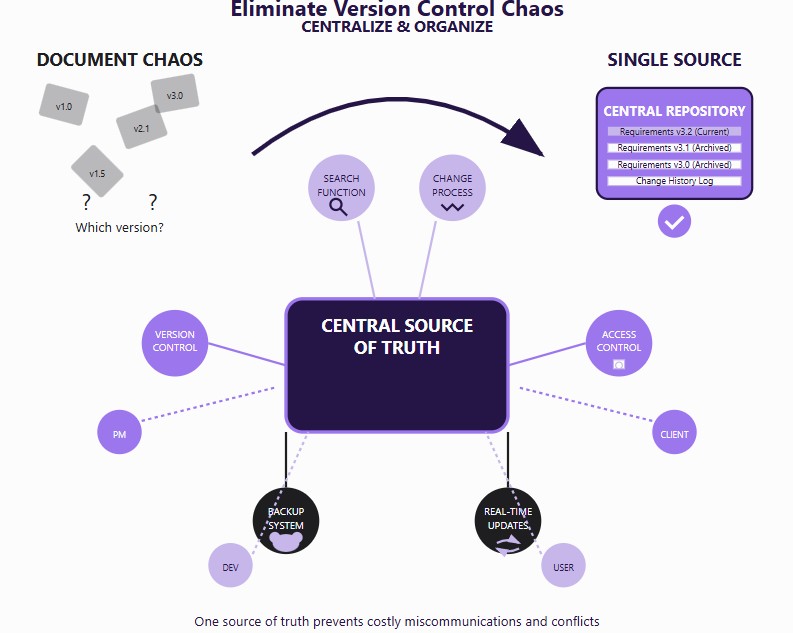
9. Continuously communicate and revisit throughout the project (stay aligned)
Stakeholder alignment isn't a one-time event; it's an ongoing process. As projects evolve, new information emerges, and circumstances change, requirements naturally shift. Regular communication and periodic realignment prevent small misunderstandings from becoming major project derailments.
Ongoing alignment strategies:
- Regular stakeholder meetings: Schedule consistent check-ins with key players
- Progress updates: Share how requirements are being implemented
- Change impact assessments: Evaluate how proposed changes affect other requirements
- Milestone reviews: Formally reassess alignment at major project phases
- Feedback loops: Create mechanisms for stakeholders to raise concerns quickly
- Retrospectives: Learn from alignment successes and failures
Pro Tip: Implement a "requirements health check" at regular intervals. Rate the current level of stakeholder alignment on a scale of 1-10 and identify specific actions to improve low scores. This proactive approach prevents alignment from gradually degrading over time.
Perfect stakeholder alignment is impossible, but excellent stakeholder alignment is achievable with the right process, tools, and commitment.
The stakeholder alignment toolkit: What every PM should be using
Getting stakeholder alignment isn’t just about the right conversations; it’s about using the right tools to make sure those conversations turn into action. When your documentation, communication, and workflows are scattered, even the most well-aligned teams can drift apart.
Here are four categories of tools that help you capture, clarify, and communicate project requirements so everyone stays on the same page throughout the project lifecycle.

Confluence: Your living documentation command center
Confluence serves as the single source of truth where all stakeholder requirements live and breathe. Unlike static documents that become outdated the moment they're shared, Confluence creates dynamic, collaborative spaces where requirements evolve in real-time.
Key features for stakeholder alignment:
- Real-time collaborative editing allows multiple stakeholders to contribute simultaneously
- Version history tracking shows exactly when and why requirements changed
- Comment and review systems enable structured feedback from all stakeholders
- Template libraries standardize how requirements are documented across projects
- Integration capabilities connect with other project management tools seamlessly
Confluence eliminates the "which version is current?" problem that destroys stakeholder confidence. When everyone works from the same living document, alignment happens naturally.
Lucidchart & Miro: Visual clarity that eliminates confusion
Visual tools transform abstract requirements into a concrete understanding. Both Lucidchart and Miro excel at making complex stakeholder relationships and requirements visually comprehensible, but they serve slightly different purposes.
Lucidchart strengths:
- Professional process flow diagrams that clearly show requirement dependencies
- Stakeholder mapping templates to visualize influence and decision-making hierarchies
- System architecture diagrams that help technical and non-technical stakeholders align
- Advanced diagramming capabilities for complex enterprise requirements
Miro advantages:
- Infinite collaborative whiteboards are perfect for brainstorming sessions with large stakeholder groups
- Real-time sticky note collaboration during virtual requirements workshops
- Interactive templates for stakeholder analysis and user journey mapping
- Facilitator-friendly features that keep large group sessions organized and productive
Both tools solve the critical problem of miscommunication through assumptions. When stakeholders can see exactly how their requirements connect and interact, alignment becomes dramatically easier.
Dart: AI-powered requirements intelligence
Dart revolutionizes stakeholder alignment through artificial intelligence that understands project context and automates routine alignment tasks. This Y Combinator-backed tool uses GPT-4 technology to eliminate administrative overhead that typically consumes hours of stakeholder management time.
Revolutionary features for requirements alignment:
- AI-powered automatic report generation creates stakeholder updates without manual effort
- Intelligent task breakdown transforms high-level stakeholder requirements into actionable subtasks
- Smart duplicate detection prevents conflicting requirements from different stakeholders
- Natural language processing allows stakeholders to communicate requirements in plain English
- Automated categorization and prioritization organize stakeholder input without manual sorting
- Command center interface enables rapid navigation and requirement management
Dart's AI capabilities mean teams save up to 7 hours per week on project management overhead, allowing more time for actual stakeholder engagement and relationship building. The tool learns from your team's patterns and improves its recommendations over time.
Slack & Microsoft Teams: Continuous alignment communication
Real-time communication platforms keep stakeholder alignment alive between formal meetings. Both Slack and Teams create persistent communication channels where stakeholder questions get immediate answers and requirement clarifications happen instantly.
Essential alignment features:
- Dedicated project channels keep all stakeholder communication in one searchable location
- Thread-based discussions organize complex requirement conversations logically
- File sharing and preview allow instant access to the latest requirement documents
- Integration ecosystems connect with all your other stakeholder management tools
- Mobile accessibility ensures stakeholders can stay aligned from anywhere
- Notification customization prevents information overload while maintaining responsiveness
The key advantage is preventing small misunderstandings from becoming major alignment problems. When stakeholders can get quick clarification on requirements, projects stay on track.
The investment in proper stakeholder alignment tools pays dividends in reduced rework, faster decision-making, and higher project success rates. Choose tools that match your team's working style and stakeholder preferences.
Drive alignment with process, not assumptions
Stakeholder alignment doesn’t happen by chance; it’s the result of deliberate actions, clear communication, and the right tools. From identifying every key player to documenting SMART requirements and using AI-powered platforms like Dart, this process turns complexity into clarity.
When you rely on structure instead of assumptions, you gain faster buy-in, fewer surprises, and projects that deliver exactly what’s expected. Start leading with alignment, every step of the way.


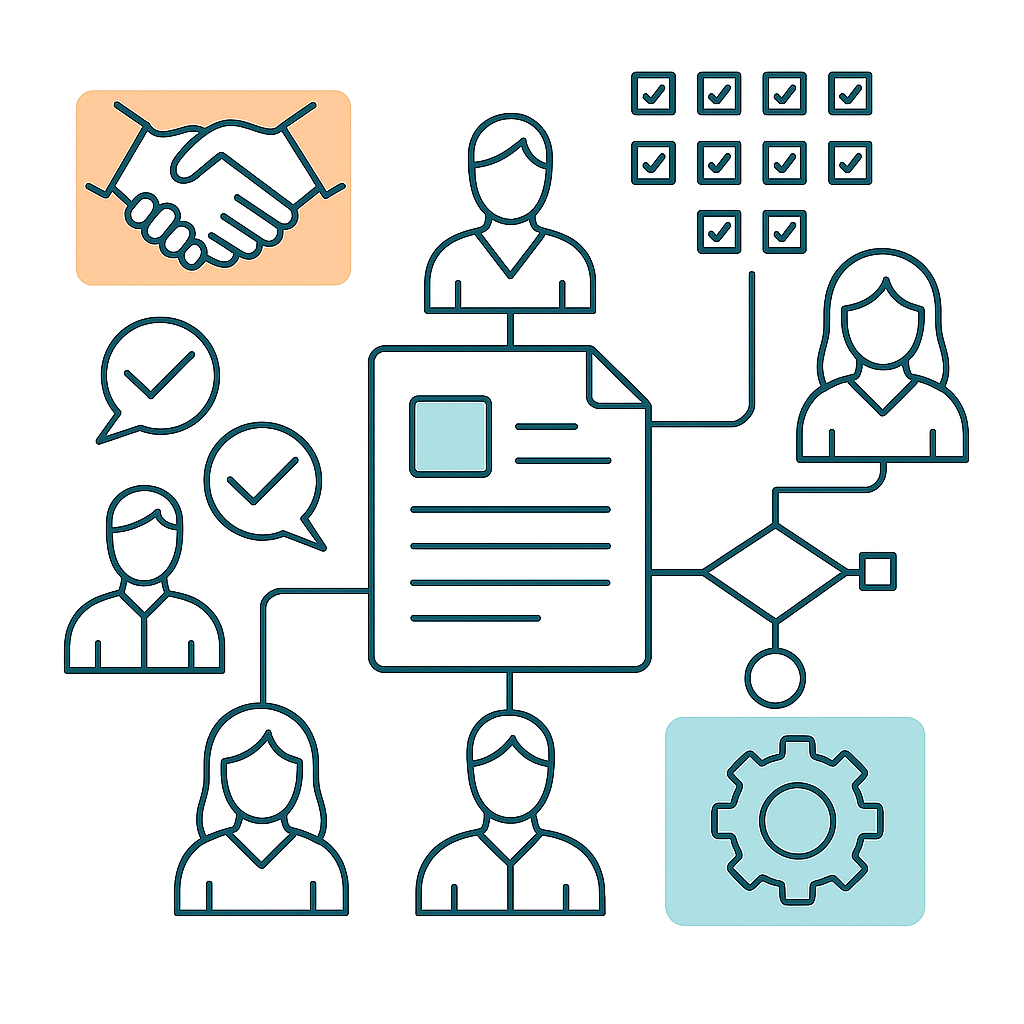
_light%201.png)





